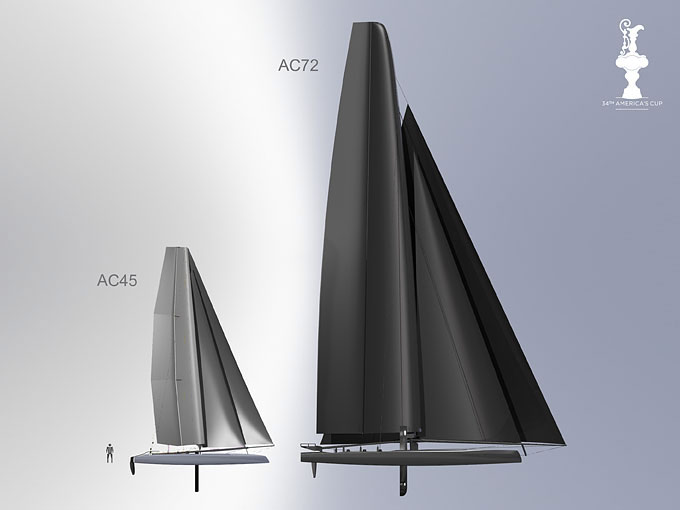|
|
||||||||||||||||||||||||||||||
|
New America’s Cup Era Begins with
Wingsail Catamaran Valencia, September 13, 2010 |
||||||||||||||||||||||||||||||
|
The America’s Cup has pioneered yacht design for 159 years. In the 34th America’s Cup the best sailors in the world will meet their ultimate match; the fastest boat in the world. Technology returns to the fore with the AC72 wingsail America’s Cup catamaran, capable of regularly exceeding speeds of 30 knots. The AC72 will excite fans as it zips around the racecourse with one hull in the air. Equally important, it will leave the crews exhilarated and drained after a day of adrenaline-fueled racing. Crucial to the new boat is its ability to be raced hard in light and strong winds, a necessary development to do away with the frustrating delays of racing because of not enough wind or too much. Fast to grab and retain the attention of a new audience, it also had to be technically stimulating to design and physically demanding for the crew to sail. There will only be 11 crewmembers, six fewer than the heavy-displacement ACC monohull it replaces. “The AC72 Class adds a new dimension to America’s Cup design and technology,” said Pete Melvin, a chief architect of the rule and champion multihull sailor. “The AC72 will place exacting demands on the helmsman, crew and support team that the vast majority of us who call ourselves ‘weekend racers’ could never hope to develop.” The new class of America’s Cup catamaran is a tightly defined “box rule.” Certain parameters have been set, such as overall length, beam, displacement and sail area. Other factors are limited to keep the competition close across all wind speeds. So that no team would have an unfair advantage by creating the rule, US SAILING and Morrelli & Melvin Design & Engineering authored the rule. “Near the beginning of the process we were requested to look at a catamaran instead of a trimaran because it’s easier to transport, assemble and disassemble,” Melvin said. “The difference in the performance characteristics is not significant, and a cat was judged less expensive to build. From there, the experience of two America’s Cups in which wingsails were used (1988 and 2010), coupled with the latest developments in wingsail technology, made it natural to morph the design rule into a catamaran with a wingsail,” said Melvin.
The catamaran will be able to fly a hull in 5 to 6 knots true windspeed. The target boatspeeds in winds under 10 knots were set at 1.2 times the true windspeed upwind and 1.6 times true windspeed downwind. High speeds are derived from enormous power. The AC72 has a righting moment of approximately 60-ton-meters. Determining the sail plan dimensions was difficult because the boat has to be powerful in light winds and not overpowered in stronger winds. “It’s been challenging to have the cat fully powered-up and flying a hull in light winds, yet also able to sail in 30 knots,” Melvin said. “We put a lot of time and effort into sizing the wingsail and the platform dimensions in order to sail in that full range.” The height of the wingsail will be approximately 40 meters (130 feet) with a maximum chord length between 10 and 11 meters (32 and 36 feet). Two options for depowering are removable flaps on the upper leech or a removable mast tip. Both options would reduce sail and weight. With such a wide boat, additional structure has been required to optimize the longitudinal stability of the AC72 to dampen flexing and to resist the high forestay loads. A draft of the AC72 Rule has been completed and the final rule will be issued by September 30. Other highlights of the new class:
The Youth America’s Cup and AC45 The next generation of sailing heroes will be created by the Youth America’s Cup, a new global sports event that will take place annually from 2012. National teams will compete in the AC45, the new, fast, wingsail one-design catamaran that America's Cup teams will race during 2011. Competition rules for the Youth America’s Cup are in development and will be announced by June 2011, following the close of the challenge period for America's Cup teams.
The AC45 is not only a launch pad for young sailors around the world, but will also fast-track America's Cup teams straight to the latest state-of-the-art wingsail technology. The AC45 class will be managed by the new independent America's Cup Race Management and built by Core Builders in Warkworth, New Zealand. Six new boats are underway with hull no.1 due to be launched in December 2010. All America’s Cup teams will be invited to take part in the sea trials. The platforms, hulls and cross beams, will be delivered to America’s Cup teams with all composite work completed. Only assembly, painting and instrumentation fit-out will remain. The wingsails will be supplied either as a
finished product or in a kit with assemblage information supplied
as per the class rule. Related Links: Read Protocol for the 34th America's Cup (41 pages, pdf) At America's Cup Official Web site: View Press Conference Video Additional Links and Info:
Visit
Club Nautico di Roma website |
||||||||||||||||||||||||||||||

